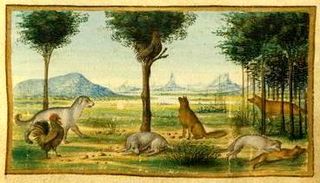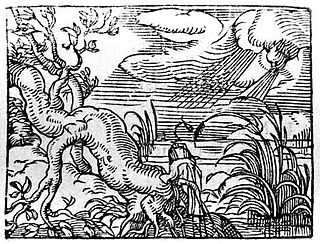A fable is a story intended to illustrate a moral.
Fable(s), The Fable(s), or A Fable may also refer to:
A fable is a story intended to illustrate a moral.
Fable(s), The Fable(s), or A Fable may also refer to:

Fable is a literary genre defined as a succinct fictional story, in prose or verse, that features animals, legendary creatures, plants, inanimate objects, or forces of nature that are anthropomorphized, and that illustrates or leads to a particular moral lesson, which may at the end be added explicitly as a concise maxim or saying.

Jean de La Fontaine was a French fabulist and one of the most widely read French poets of the 17th century. He is known above all for his Fables, which provided a model for subsequent fabulists across Europe and numerous alternative versions in France, as well as in French regional languages.

Aesop's Fables, or the Aesopica, is a collection of fables credited to Aesop, a slave and storyteller who lived in ancient Greece between 620 and 564 BCE. Of varied and unclear origins, the stories associated with his name have descended to modern times through a number of sources and continue to be reinterpreted in different verbal registers and in popular as well as artistic media.

"The Tortoise and the Hare" is one of Aesop's Fables and is numbered 226 in the Perry Index. The account of a race between unequal partners has attracted conflicting interpretations. The fable itself is a variant of a common folktale theme in which ingenuity and trickery are employed to overcome a stronger opponent.

The Fox and the Grapes is one of Aesop's Fables, numbered 15 in the Perry Index. The narration is concise and subsequent retellings have often been equally so. The story concerns a fox that tries to eat grapes from a vine but cannot reach them. Rather than admit defeat, he states they are undesirable. The expression "sour grapes" originated from this fable.

The Ant and the Grasshopper, alternatively titled The Grasshopper and the Ant, is one of Aesop's Fables, numbered 373 in the Perry Index. The fable describes how a hungry grasshopper begs for food from an ant when winter comes and is refused. The situation sums up moral lessons about the virtues of hard work and planning for the future.

The Monkey and the Cat is best known as a fable adapted by Jean de La Fontaine under the title Le Singe et le Chat that appeared in the second collection of his Fables in 1679 (IX.17). It is the source of popular idioms in both English and French, with the general meaning of being the dupe of another.

The Dog and Its Reflection is one of Aesop's Fables and is numbered 133 in the Perry Index. The Greek language original was retold in Latin and in this way was spread across Europe, teaching the lesson to be contented with what one has and not to relinquish substance for shadow. There also exist Indian variants of the story. The morals at the end of the fable have provided both English and French with proverbs and the story has been applied to a variety of social situations.

Belling the Cat is a fable also known under the titles The Bell and the Cat and The Mice in Council. In the story, a group of mice agree to attach a bell to a cat's neck to warn of its approach in the future, but they fail to find a volunteer to perform the job. The term has become an idiom describing a group of persons, each agreeing to perform an impossibly difficult task under the misapprehension that someone else will be chosen to run the risks and endure the hardship of actual accomplishment.

The Fox and the Crow is one of Aesop's Fables, numbered 124 in the Perry Index. There are early Latin and Greek versions and the fable may even have been portrayed on an ancient Greek vase. The story is used as a warning against listening to flattery.

Aesop is an almost certainly legendary Greek fabulist and storyteller, said to have lived c. 620–564 BCE, and credited with a number of fables now collectively known as Aesop's Fables. Although his existence remains unclear and no writings by him survive, numerous tales credited to him were gathered across the centuries and in many languages in a storytelling tradition that continues to this day. Many of the tales associated with him are characterized by anthropomorphic animal characters.

The Milkmaid and Her Pail is a folktale of Aarne-Thompson-Uther type 1430 about interrupted daydreams of wealth and fame. Ancient tales of this type exist in the East but Western variants are not found before the Middle Ages. It was only in the 18th century that the story about the daydreaming milkmaid began to be attributed to Aesop, although it was included in none of the main collections and does not appear in the Perry Index. In more recent times, the fable has been variously treated by artists and set by musicians.
The Bear and the Gardener is a fable originating in the ancient Indian text Panchatantra that warns against making foolish friendships. There are several variant versions, both literary and oral, across the world and its folk elements are classed as Aarne-Thompson-Uther type 1586. The La Fontaine version has been taken as demonstrating various philosophical lessons.

The Cock, the Dog and the Fox is one of Aesop's Fables and appears as number 252 in the Perry Index. Although it has similarities with other fables where a predator flatters a bird, such as The Fox and the Crow and Chanticleer and the Fox, in this one the cock is the victor rather than victim. There are also Eastern variants of this story.

The Oak and the Reed is one of Aesop's Fables and is numbered 70 in the Perry Index. It appears in many versions: in some it is with many reeds that the oak converses and in a late rewritten version it disputes with a willow.
Aesop's Fables are a collection of fables credited to Aesop, a slave and story-teller believed to have lived in ancient Greece between 620 and 560 BCE.

Jean de La Fontaine collected fables from a wide variety of sources, both Western and Eastern, and adapted them into French free verse. They were issued under the general title of Fables in several volumes from 1668 to 1694 and are considered classics of French literature. Humorous, nuanced and ironical, they were originally aimed at adults but then entered the educational system and were required learning for school children.
The Old Man and Death is one of Aesop's Fables and is numbered 60 in the Perry Index. Because this was one of the comparatively rare fables featuring humans, it was the subject of many paintings, especially in France, where Jean de la Fontaine's adaptation had made it popular.

Hercules and the Wagoner or Hercules and the Carter is a fable credited to Aesop. It is associated with the proverb "God helps those who help themselves", variations on which are found in other ancient Greek authors.

The Weasel and Aphrodite, also known as Venus and the Cat is one of Aesop's Fables, numbered 50 in the Perry Index. A fable on the cynic theme of the constancy of one's nature, it serves as a cautionary tale against trusting those with evil temper, for even if they might change their body, they will not change their mind.